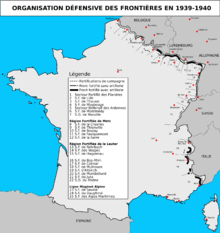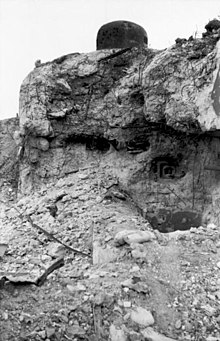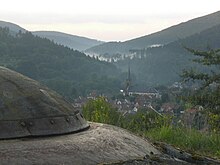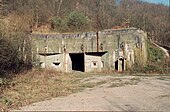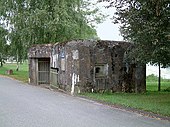Maginot Line
Battle of the Netherlands
Maastricht - Mill - The Hague - Rotterdam - Zeeland - Grebbeberg - Afsluitdijk - bombing of Rotterdam
Invasion of Luxembourg
cobblestone line
Battle of Belgium
Fort Eben-Emael - KW line - Dyle plan - Hannut - Gembloux - Lys
Battle of France
Royal Marine - Ardennes - Sedan - Maginot Line - Weygand Plan - Arras - Boulogne - Calais - Dunkirk ( Dynamo - Wormhout ) - Abbeville - Lille - Paula - Fall Rot - Aisne - Alps - Cycle - Saumur - Lagarde - Aerial - Fall Braun
The Maginot Line ([ maʒi'noː ], French Ligne Maginot ) was a defense system consisting of a line of bunkers along the French border with Belgium , Luxembourg , Germany and Italy . The system is named after the French Defense Minister André Maginot . It was built from 1930 to 1940 to prevent or repel attacks from these neighboring countries or the hegemonic powers Germany and Italy that might attack over their territories. In addition, the southern tip of Corsica was fortified.
Usually only the part along the German border is referred to as the Maginot Line, while the term Alpin-Linie is used for half of it to Italy .
The idea of such a defensive line already existed immediately after the Franco-Prussian War in 1871. In 1874 the French began building the Barrière de fer ("Iron Barrier"), which consisted of numerous fortresses , forts and other similar structures.
These were bricked and proved to be no match for the explosive shells that appeared in 1890 .
The Germans built the Siegfried Line (= Hindenburg Line) in the second half of the First World War in order to shorten their front line, to save material and people and to be able to withstand the increasing Allied superiority after the American entry into the war. The Allies were only able to break through this defensive structure in places through the Meuse-Argonne offensive (September 26 to November 11, 1918 in the Verdun sector). The Maginot Line was to become a similar defensive structure.
Prehistory of the French fortress construction
The construction of defensive fortifications has a long tradition in France. Historically, this approach to defense was primarily shaped by Sébastien Le Prestre de Vauban . For centuries they prevented it from being taken.
history
Planning and construction
One of the main reasons for France's defensive orientation towards Germany was its population development : Due to its stagnating population, France found it increasingly difficult during the decades after 1870 to maintain a possibly offensively oriented mass army at a numerical level comparable to that of its expanding neighbors Germany could accommodate. Horrific war losses in the years 1914–1918 - around 1.3 million French died - further worsened France's position vis-à-vis the neighboring country, which with almost 70 million had almost 30 million more inhabitants than France. Immediately after the end of the First World War, the French government (1917–1920 under Georges Clemenceau ) commissioned the General Staff with a study to defend the French borders in order to be prepared after the experience of 1914 against a possible new German invasion. The best-known participants in the study were Marshals Ferdinand Foch , Philippe Pétain and Joseph Joffre . Foch was averse to static defense systems, Joffre advocated a solution based on the model of the fortresses of Verdun , Toul and Épinal , Pétain preferred a linear and fortified front.
Paul Painlevé , Minister of War from November 1925 to July 1929 , set up two commissions: The Commission for the Defense of the Frontiers (Commission de défense des frontières - CDF) with the task of planning the general layout and organization and submitting a cost estimate Commission for the organization of fortified areas (Commission d'organization des régions fortifiées - CORF), which was supposed to prepare the results of the CDF for practical implementation.
In early 1929 the CORF concept was adopted by the Council of Ministers . Painlevé handed over his office to his successor André Maginot in July 1929 . Maginot submitted the program to parliament as a draft law and had it voted openly on January 14, 1930. Over 90 percent of the MPs agreed. The decisive factor in the decision to build the Maginot Line was probably the successful defense of France on the fortress ring of Verdun. The German troops were unable to break through this in 1916.
Maginot died unexpectedly in January 1932.
The main parts of the line were built until 1936. With the increasing threat from the German Reich , the insight into the necessity of the project grew. The official costs totaled 5 billion old French Francs . In November 1936, 1,000 kilometers of the Maginot Line were considered completed.
In the planning, the possibility of a massive enemy tank attack was not considered or ignored. Based on experiences from the previous war, the defenses were only designed to ward off infantry attacks. The most important elements of the Maginot Line were to function as newly developed artillery works with retractable turrets, which, equipped with 75 mm cannons and 138 mm howitzers , were to stand at a distance of ten kilometers. The space between the artillery works was to be protected by lightly armed infantry works and casemates . Overall, the defensive line was poorly equipped with only 344 artillery pieces and 500 anti-tank guns - based on the total length. The individual systems were equipped with their own energy supply and ventilation system. Larger artillery works had electrically operated field railways . Up to 20,000 workers were employed in the construction of the Maginot Line in the early 1930s (during the Great Depression ).
108 artillery works had been built by 1940, almost half of them on the border with Italy. The Maginot Line was, however, unlike in the French and German propaganda, not a continuous line of defense. Rather, it consisted of a large number of independent and isolated fortifications. The infantry works had crews of around 100 soldiers, the smaller artillery works had 150-200 men, and the larger ones had up to 600 men.
A major disadvantage of the Maginot line was that it was far too labor-intensive. A Maginot line extending to the North Sea would have tied up a large part of the French army due to the high personnel requirements and made offensive actions impossible. That is why the defense system was only fully developed as far as Sedan . Individual sections, for example on the Meuse , had been built without any artillery works due to financial restrictions. The sections between Sedan and Lauterbourg were very strongly fortified, but on the Rhine side at the start of the war the equipment had not yet arrived everywhere, so that the positions here were insufficiently equipped. In addition, the bunker line was not finished everywhere. In the Jura there are casemates whose formwork has not yet been removed. Because of the high cost of the plants in Alsace, other sections had to be neglected. In some cases, iron sentry houses from the First World War were even set in concrete and converted into observation stands, as in the Sundgau position.
The French population felt safe after the billions were passed and relied too much on this publicly praised line of fortification. Initiatives by other politicians to prepare more offensive tactics were not taken or taken too late because they were initially rejected on the grounds that the Maginot Line was insurmountable. At that time there was a pronounced defensive attitude in the French military (while offensive à outrance - attack to the extreme - was still the doctrine in World War I ).
One of the critics of the Maginot Line was Charles de Gaulle (see here ).
Course of the war on the Maginot Line
When attacking France in 1940 , the German attack leaders aimed at the line's weak points. Similar to the old Schlieffen Plan from the First World War, some of the Wehrmacht units took the route through Belgium and thus bypassed the entire line, while the main attacking point decisively penetrated the line on a poorly developed section in the Ardennes .
The Allies expected that the German attackers would be forced to pass through Belgium because of the fortifications, and moved most of their best formations to Belgium. When the French 1st Army , the Belgian Army and the British Expeditionary Force met the Wehrmacht there, this reinforced their view that the German attack would again come through Belgium - while the German fast panzer divisions unexpectedly broke through the barely defended Ardennes and bypassed the Maginot Line at Sedan . The bulk of the Allied armies, standing in Belgium and northern France, was trapped in the direction of the canal by the breakthrough of German tank units known as the “ sickle cut ” . Over 300,000 British and French soldiers who were already trapped near Dunkirk were evacuated to England via the English Channel in Operation Dynamo (the so-called miracle of Dunkirk ). The delay in the attack on the trapped Allied troops (see stop order ) later turned out to be a decisive mistake by the Germans. France had to surrender after failure to build a new line of defense: the forces remaining in the country were generally too weak.
Attacked fortifications usually did not withstand the dropping of bombs by Stukas , direct fire with 8.8 cm flak and the use of shaped charges . Often the crews in infantry factories without guns had to watch helplessly as the Germans pulled their guns and began direct fire beyond the firing range of French machine guns. The resistance often lasted no longer than 48 hours, as all machine guns and anti-tank guns (Paks) were then destroyed and the ventilation turned out to be a weak point, as it frequently failed. For example, the 107-man crew of the La Ferté infantry plant in the Montmédy section was killed by pent-up poisonous explosion gases despite gas masks. Both bunkers had no artillery and could therefore be quickly put out of action by the attackers. The French then fled to deeper areas of the infantry plant and suffocated there.
Even after the surrender, the French flag was still flying on many of the Maginot Line's works - the Wehrmacht made no attempt to capture it. The German troops contented themselves with cutting off the individual bunkers and factories, enclosing the crews in their facilities and thus effectively neutralizing them. Parts of the line could probably have held out for months, but that would have been pointless in view of the occupation of France. Some of the commanders of various factories, including that of the Four à Chaux , nevertheless refused to obey the surrender and hand over the forts to the Wehrmacht - true to their outdated and then recognizably meaningless motto: "And they won't get through!" In a daily order of July 1, 1940, the Commander-in-Chief of France, General Maxime Weygand , paid tribute to the 22,000 remaining and thus bound defenders of the now meaningless Maginot Line.
The Maginot Line today
Many works ( French : ouvrage ) of the Maginot Line can be visited today - some are or are being restored and include smaller exhibitions. Including:
- Fort Hackenberg , one of the largest bunkers on the Maginot Line; served as a prototype for other fortifications on the Maginot Line. It had its own casemate railway ; this is still operational today.
- Fort Michelsberg , the artillery plant is located in the Boulay fortress sector between Dalstein and Ébersviller near Fort Hackenberg (F57320).
- Fort Simserhof near Bitche (German Bitsch) not far from Zweibrücken .
- Fort de Schoenenbourg near the village of Schoenenbourg south of Wissembourg (Weißenburg).
- Four à Chaux (Fort Kalkofen) near the village of Lembach not far from Wissembourg .
- La Ferté south of Sedan , one of the few forts that was immediately conquered by German troops.
- Casemate Marckolsheim (Mémorial-Musée) southeast of Sélestat (Schlettstadt) .
- Fort Casso near Rohrbach-lès-Bitche .
Germany built a counterpart to the Maginot Line at the end of the 1930s in the form of the West Wall . The Czechoslovak Wall was built between 1935 and 1939, also based on the Maginot Line .
The entrance of Fort Michelsberg
Entrance to the Schoenenbourg artillery plant
Casemate Grand Lot near Thionville
Tank bell at Col de Guensthal near Windstein
organization
Although the name “Maginot Line” indicates a narrow area of fortifications, the bunker system was de facto staggered up to 25 km deep. It consisted of a system of bunkers, fortresses and other military facilities such as border posts, communication centers, infantry shelters, barricades, depots, observation points, artillery, anti-tank and machine gun fortifications adapted to the terrain. These facilities made the system as a whole a heavily armed but rigid defense system with limited range and room for maneuver.
From the border to the hinterland, the system consisted of:
Border post
These uniform concrete bunkers were mostly camouflaged as normal residential buildings and were erected a few meters from the border. They were occupied with troops in order to slow down surprise attacks right from the start. Barricades and explosives against tanks were already prepared for this.
Outpost and support line
A number of anti-tank bunkers had been set up about five kilometers across the border to delay tank attacks. This delay was intended to ensure that the main defense positions behind it could be manned in good time. These positions also secured the main roads connecting the defensive positions and to the border.
Fortress section (French Secteur Fortifié )
In a moderate expansion, such a section consisted mainly of casemates located about 1 km apart, such as on the Rhine front. The heavy expansion can be found at Thionville , for example , where a continuous line of artillery and infantry with casemates in between formed the main battle line.
Blocked section (French Secteur Défensif )
Such sections are mostly based on obstacles that are difficult to cross, such as damming (Saar section; see e.g. Ouvrage Simserhof ) or wooded and mountainous terrain ( Ardennes ) and were therefore only weakly fortified with small combat systems and log houses .
Fortress troops
The operational interwar thinking in France was shaped by Marshal Henri Philippe Pétain , the inspector general of the French army and later head of the French Vichy government that worked with the German occupiers . In view of the terrible losses France suffered in its offensive operations in World War I and based on personal defensive successes ("Hero of Verdun "), he gave pure defense the highest priority. Accordingly, the French army was mainly set up defensively. Most of the units were set up directly in or just behind the Maginot Line, so that relatively few offensive forces were available. The main combat forces of the twelve fortress divisions were:
RAP (French Régiment d'artillerie de Position ) fortress artillery regiments
RIF (French Régiment d'infanterie de Forteresse ) fortress infantry regiments
Fortifications
Types
Artillery Works ( French Gros Ouvrage )
These works represented the largest fortifications within the Maginot Line. There is always a large spatial separation between combat blocks and entrance systems, so that new teams and ammunition can be brought in away from combat. Between 250 and 1100 men were accommodated in it and thanks to their own power supply, large stocks of food, drinking water, fuel and ammunition, they were able to fight the fire completely independently for a long time. Consisting of 4 to 17 combat blocks, these systems had a certain number of 75-mm cannons , 135-mm howitzers and 81-mm grenade launchers, depending on their order .
Observation bunker ( French observatoire )
As the actual eyes of the Maginot Line, these bunkers, built on an elevated position, were provided with about 3.5 m thick concrete ceilings to withstand even the strongest artillery fire. In addition to telephony and, in some cases, radio equipment, there were observation bells for guiding the artillery fire.
Blockhaus (French blockhouse )
In the Maginot Line, a block house was a single-storey concrete bunker with thin walls, in which there was at most one standby room next to the combat rooms. The weapons served to protect the neighboring plants. The bunkers, occupied by a maximum of 16 men, only had hand ventilators for gas protection and kerosene lights.
Large shelter ( French Abri )
Up to 250 men could be accommodated in these concrete barracks. They belonged to the interval troops, which should operate as mobile units between the actual fortress works. In these large bunkers, which were available in an above-ground version (French abri de surface ) and an underground version (French abris-cavernes ), there were rest and standby rooms , a gas filter system , a generator, a kitchen and a fresh water tank.
Infantry factory ( French Petit Ouvrage )
In the infantry works of the Maginot Line, only a few 81-mm grenade launchers were installed as artillery weapons . All of them had at least one machine-gun or a 25-mm anti-tank gun turret . All in all, these were armed with only between 35 and 230 men, significantly less armed than the artillery works . Some of them were designed for a later expansion, which was not due to financial restrictions. These works were also equipped with relaxation rooms, a kitchen, their own power supply, etc.
Casemate ( French Casemate )
A casemate represented an independent, mostly two-story combat facility within the Maginot Line. Rest and standby rooms, a gas protection filter system, a generator, kitchen and fresh water tank were available for the crew of up to 50 men. The weapons served to protect the neighboring plants.
Small combat facility ( French Abri de tir )
The various types of small combat systems in the Maginot Line all consisted of the actual combat area for MG or anti- tank guns . There were no rest or standby rooms for the teams. There was also no electricity connection or gas protection.
Names of the fighting blocks
For the large fortifications of the Maginot Line, the artillery works (French: Gros Ouvrage ), a distinction was usually only made between combat blocks (French: blocs de combat ) and entrance blocks (French: entrées ). Some represent the heart of the fortress from which the fire fight was fought, the others are far removed from it and intended for the tracking of men and ammunition. In more recent releases, the combat blocks are further subdivided:
Artillery bunker
This block only has turret guns (75, 81 or 135 mm), and the bunker ceiling is flush with the surface - all other parts of the system (ready rooms, ammunition stores, etc.) are arranged underground.
Artillery casemate
In such a block, the fighting compartment is completely above the ground. His artillery weapons (75, 81 or 135 mm) only act as a flank to protect neighboring plants. Since they are thus protected from direct fire, they constantly protrude from the concrete gap. Often three 75 mm cannons are arranged here next to each other.

Infantry bunker
This block only has armored bells. The bunker ceiling is flush with the surface - all other parts of the facility (standby rooms, ammunition stores, etc.) are underground. Such bunkers were armed only with light machine guns.
Infantry casemate
Such a block was equipped with anti-tank cannons and heavy twin machine guns, which acted as a flank to protect the neighboring plants. In some of them, machine gun turrets or 25 mm anti-tank gun turrets were also installed. On these casemates there were several armored bells with machine guns.
Armament and optics
| Tower and casemate guns |

|
| Extension and retraction of the tower |
| designation | Weapon type | Range | Tower weight | cadence | Examples | |
| 75 mm tower or casemate | cannon | 9.5-12 km | 189-265 tons | 13 S / min |  |

|
| tower | casemate | |||||
| 81 mm tower or casemate | Grenade launcher | 3.5 km | 125 t | 15 S / min |  |

|
| Casemate from the outside (the two lower notches) | Casemate from the inside | |||||
| 135 mm tower or casemate | howitzer | 5.6 km | 163 t | 6 S / min |

|
|
| MG turret | MAC-31 | 3 km | 96 t | 450 rpm |

|
|
| 25 mm anti-tank gun turret | 25mm Pak and MAC-31 | 3 km / 450 m | 135 t | 20/450 s / min |

|
|
| 37/47 mm pack | Anti-tank gun | 3 km | 15 S / min |

|
||
| 47 mm pack / 1 × ZMG | The Pak ( Canon de 47 mm AC modèle 1934 ) was attached to a rail on the ceiling and could be withdrawn, then the twin MG was folded into the notch. |

|
||||
Bells or domes
The steel armor was 20 to 30 cm thick and weighed between 11 and 35 t.
| designation | French | comment | Examples |
| AM bell | Arms mixed | A so-called combination weapon with a 25-mm anti-tank gun (Pak) and a machine gun was built into this bell. |

|
| GFM bell | Guetteur fusil mitrailleur | Optics for observation, a light machine gun ( MAC-24/29 ) or a light 50 mm grenade launcher could be used in the notches of this bell . |

|
| JM bell | Jumelage mitrailleuse | A heavy twin machine gun ( MAC-31 ) was permanently built into this bell . |

|
| LG bell | Lance grenade | This bell was intended for the 50 mm and 60 mm grenade launchers, but these weapons were no longer delivered on time. |

|
| VDP bell | Vision directe et periscopique | From this bell it was possible to observe directly through a narrow viewing slit with appropriate optics or with an extendable periscope. |

|
Legends
The rapid collapse in June 1940 damaged the reputation of the previously highly valued French armed forces. The result was ridicule, contempt and insinuations, also on the part of the Anglo-American allies. The legend continues to this day that gun forts were built during the construction of the Maginot Line because of bad planning
- "The wrong way round", ie with the direction of fire in the French hinterland, or
- with a limited range so that the German troops who approached the line from behind after bypassing could not be shot at,
or
- with the entrance areas open at the back
This was last seen in the book Dude, Where's My Country? (Full cover, Mr. Bush) distributed by Michael Moore .
It should be noted that the Maginot Line, at that time at the highest level of technical possibilities, but not the classical art of fortification, of course also had forts facing the hinterland in order to be able to cover other works. It is wrong that the line was built the wrong way round or that its guns could not have rotated adequately - yet the line as a whole intended functionary could ultimately contribute almost nothing to the defense of France, which may favor such legends.
See also
- List of ouvrages of the Maginot Line - structures, bunkers
- Westwall - the German fortification to the west
- Atlantic Wall - the wall built by Germans in occupied France on the Atlantic coast and the English Channel coast
literature
- Klaus-Jürgen Bremm : The Maginot Line 1930–1940. In: Military & History. 46, 2009, pp. 20-25, ZDB -ID 2088896-X .
- Jean-Yves Mary: La Ligne Maginot. Ce qu'elle était, ce qu'il en reste . New edition. Sercap, Paris 1985, ISBN 2-7321-0220-2 .
- High Command of the Army, Department Evaluation of Foreign Fortifications (Ed.): Memorandum on French fortifications . (For official use only). Berlin 1942.
- Philippe Truttmann: La muraille de France ou la ligne Maginot . New edition, checked and corrected. G. Klopp, Thionville 1988.
- Jean-Bernard Wahl: Then and Now - The Maginot Line. Northern France - Lorraine - Alsace. History and travel guide . Mittler, Hamburg a. a. 2000, ISBN 3-8132-0685-8 .
Web links
- www.maginot.org
- www.lignemaginot.com
- Website of the Four à Chaux fortress (lime kiln), Alsace
- Maginot Line today photos, videos, reports, updates
- Maginot Line in the 1939–1940 war
- Literature on the Maginot Line in the catalog of the German National Library
- Maginot Line - Arms (Czech)
- The Maginot Line: photos, armament, explanations, plans, ...
- Pictures and information about the Maginot Line and its works
- How Hitler overran France 70 years ago . World online
- Fortresses of the Maginot Line (photographic documentation of many works of the Maginot Line)
